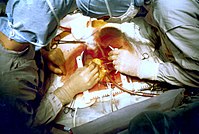
Photo from wikipedia
Tetralogy of Fallot is the most common form of cyanotic congenital heart disease. As a result of the surgical strategies employed at the time of initial repair, chronic pulmonary regurgitation… Click to show full abstract
Tetralogy of Fallot is the most common form of cyanotic congenital heart disease. As a result of the surgical strategies employed at the time of initial repair, chronic pulmonary regurgitation (PR) is prevalent in this population. Despite sustained research efforts, patient selection and timing of pulmonary valve replacement (PVR) to address PR in young asymptomatic patients with repaired tetralogy of Fallot (rToF) remain a fundamental but as yet unanswered question in the field of congenital heart disease. The ability of the heart to compensate for the chronic volume overload imposed by PR is critical in the evaluation of the risks and benefits of PVR. The difficulty in clarifying the functional impact of PR on the cardiovascular capacity may be in part responsible for the uncertainty surrounding the timing of PVR. Cardiopulmonary exercise testing (CPET) may be used to assess abnormal cardiovascular response to increased physiologic demands. However, its use as a tool for risk stratification in asymptomatic adolescents and young adults with rToF is still ill-defined. In this paper, we review the role of CPET as a potentially valuable adjunct to current risk stratification strategies with a focus on asymptomatic rToF adolescents and young adults being considered for PVR. The role of maximal and submaximal exercise measurements to identify young patients with a decreased or borderline low peak VO2 resulting from impaired ventricular function is explored. Current knowledge gaps and research perspectives are highlighted.
Journal Title: Pediatric Cardiology
Year Published: 2017
Link to full text (if available)
Share on Social Media: Sign Up to like & get
recommendations!